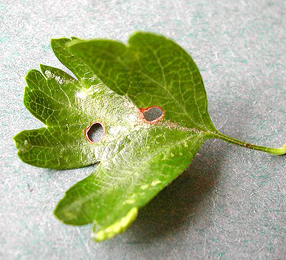|
||||||
|
Incurvaria
masculella (Denis & Schiffermüller, 1775) Feathered Bright Tinea
masculella
Denis & Schiffermüller, 1775 |
|||||||||||||||||||||||||||||||||||||||||||||||||||||||||||||||||||||||||||||||||||||||||||||||||||||||||||||||||||
Leaf-miner: The larvae mine leaves at first, forming a blotch mine, later descending to the ground in a portable case and feeding on dead leaves (UKMoths). Oviposition is by way of an ovipositor, therefore no egg shell visible. The larva makes a small, roundish, blotch; often several in a leaf. Already after its first moult it makes an excision out of the mine, in size almost equal to the blotch (3-4 mm). Thus sandwiched it drops to the ground and continues feeding on dead leaf material (Bladmineerders van Europa). The mine is also illustrated in British leafminers.
Larva: The larvae of moths have a head capsule and chewing mouthparts with opposable mandibles (see video of a gracillarid larva feeding), six thoracic legs and abdominal legs (see examples). Mining Incurvaria-larvae, while resting, take a horse-shoe like posture, unlike the larvae of Antispila species (Bladmineerders van Europa). Pupa: The pupae of moths have visible head appendages, wings and legs which lie in sheaths (see examples). Adult: The adult is illustrated in UKMoths and the Encyclopedia of Life. The species is included in mothdissection.co.uk. The ovipositor comb of masculella is illustrated in British leafminers alongside pectinea and oehlmanniella. Hosts in Great Britain and Ireland:
Hosts elsewhere:
Time of year - larvae: May-June (British leafminers). Time of year - adults: May (UKMoths). Distribution in Great Britain and Ireland: Fairly common moth over most of Britain (UKMoths) including Anglesey, Banffshire, Bedfordshire, Berkshire, Breconshire, Buckinghamshire, Caernarvonshire, Cambridgeshire, Cardiganshire, Cheshire, Cumberland, Denbighshire, Derbyshire, East Cornwall, East Gloucestershire, East Kent, East Norfolk, East Suffolk, East Sussex, East Sutherland, Flintshire, Glamorgan, Herefordshire, Hertfordshire, Kincardineshire, Leicestershire, Merionethshire, Middlesex, North Essex, North Hampshire, North Somerset, North Wiltshire, North-west Yorkshire, Shropshire, South Aberdeenshire, South Devon, South Lancashire, South Wiltshire, Stafford, Surrey, Warwickshire, West Gloucestershire, West Kent, West Norfolk, West Suffolk, Westmorland and Worcestershire (NBN Atlas) the Channel Is. (Fauna Europaea). Also recorded in Republic of Ireland and Northern Ireland (Fauna Europaea and National Biodiversity Data Centre Map). Distribution elsewhere: Widespread in continental Europe including Albania, Austria, Belarus, Belgium, Bosnia and Herzegovina, Bulgaria, Corsica, Croatia, Czech Republic, Danish mainland, Estonia, European Turkey, Finland, French mainland, Germany, Greek mainland, Hungary, Italian mainland, Kaliningrad Region, ? Luxembourg, Macedonia, Norwegian mainland, Poland, Portuguese mainland, Romania, Russia - East and Northwest, Slovakia, Spanish mainland, Sweden, Switzerland, The Netherlands and Ukraine (Fauna Europaea). NBN Atlas links to known host species:
British and Irish Parasitoids in Britain and elsewhere: Currently unknown. |
|||||||||||||||||||||||||||||||||||||||||||||||||||||||||||||||||||||||||||||||||||||||||||||||||||||||||||||||||||
| Last updated 18-Oct-2019 Brian Pitkin | ||

